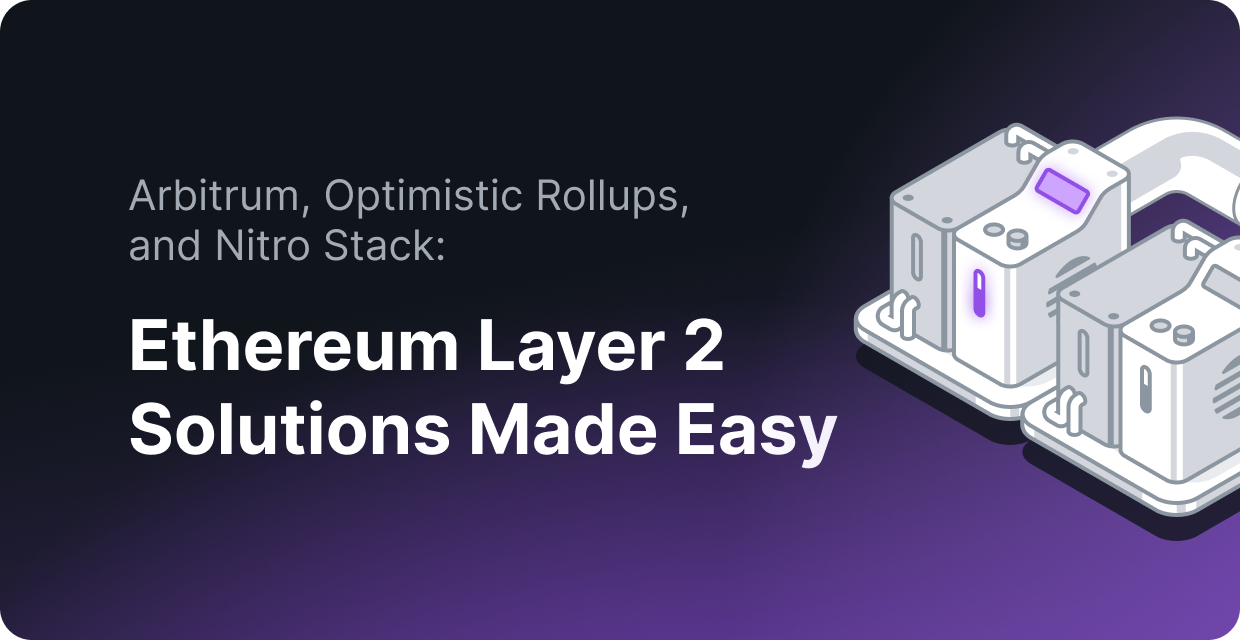Arbitrum, Optimistic Rollups, and Nitro Stack: Ethereum L2 Stack Made Easy
In this guide, we'll explore Arbitrum and its Nitro technology, highlighting its benefits for developers and businesses, and how QuickNode simplifies the deployment of these rollups.

Optimistic rollups aim to solve Ethereum’s scalability challenges by moving transaction processing off-chain while still leveraging its security and finality. However, even among these faster Layer 2 solutions, developers and businesses must conduct due diligence to achieve lower costs, faster performance, and broader support for programming languages.
This is where Arbitrum stands out with its Nitro technology. Offering faster execution, significantly lower gas fees, and enhanced developer flexibility, Arbitrum Nitro addresses the limitations that traditional optimistic rollups face. In this guide, we'll explore Arbitrum and its Nitro technology, highlighting its benefits for developers and businesses, and how QuickNode simplifies the deployment of these rollups.
What is Arbitrum Nitro?
Arbitrum Nitro is the technology stack powering Arbitrum’s Layer 2 solutions. It provides a comprehensive toolkit for building and deploying scalable, efficient decentralized applications (dApps) while leveraging familiar tools and reducing gas fees.
Nitro consists of the following layers:
- Base layer (Geth Core): Nitro uses the Go Ethereum (Geth) core for seamless EVM contract execution and state management, allowing developers to work with familiar Ethereum tools.
- Middle layer (ArbOS): This custom layer manages key Layer 2 functions such as calldata compression, gas fee management, and bridging operations, making it easier and more efficient to run dApps.
- Top layer (Node software): Based on Geth, this layer efficiently manages user requests and full node operations, allowing the node to process large volumes of Remote Procedure Call (RPC) requests smoothly, even during high traffic.
This structure is referred to as a "Geth Sandwich," where Geth forms the base and top layers, and ArbOS acts as the "filling" that manages specific Layer 2 features.
How Nitro Works
Here’s an overview of how Nitro sequences and processes transactions:
- Sequencing: The Sequencer orders transactions, compresses them, and posts the batch as calldata on Ethereum. Once these transactions are confirmed on Ethereum, they’re processed using the State Transition Function (STF).
- Execution: The STF is compiled into native machine code, enabling Nitro nodes to process transactions with maximum speed and efficiency.
- Settlement: After execution, the Layer 2 state is updated, and the batched transactions are submitted to Ethereum.
- Proving: In a dispute, two validators engage in an interactive call-and-response process, narrowing down their disagreement to a single computational step. This step is executed on Layer 1, proving which validator is correct.
Introduction to Arbitrum Orbit
Arbitrum Orbit is a permissionless framework for launching fully customizable, dedicated chains using Arbitrum technology. Orbit chains can be deployed as Layer 2 solutions that settle directly on Ethereum or as Layer 3 chains that settle on existing L2 chains like Arbitrum One.
With Orbit, developers and businesses can configure various components of their chain, including throughput, privacy settings, gas token usage, governance models, and data availability layers, offering limitless possibilities for customization.
Three Benefits of Using Arbitrum Orbit
While Arbitrum One and Arbitrum Nova are ideal for mainstream applications, some projects may require more control over their chain’s features, governance, and infrastructure.
Orbit chains allow projects to build their own AnyTrust or Rollup chains, giving them full control over their infrastructure.
Unlike Layer 2 public chains that share governance, Orbit chains can be fully customized to suit a project’s specific needs, all while leveraging Ethereum's security. Here are some other benefits of using Arbitration Orbit:
1. Customization and Flexibility
Arbitrum Orbit provides developers with unparalleled flexibility in designing and managing their own chains.
- Customizable Protocol Logic: Tailor settlement, execution, or governance protocols to specific needs while maintaining Ethereum’s security through Arbitrum's L2 chains.
- Flexible Technology Options: Choose between Rollup, AnyTrust, or custom stacks, optimizing for performance and decentralization.
- Permissioned access: Deploy contracts in an open, permissionless environment or restrict deployment to specific applications or users. This gives developers flexibility in managing the access and usage of their blockchain environment.
2. Improved Performance and Scalability
For developers building resource-intensive dApps, Arbitrum Orbit ensures dedicated throughput, providing high performance and consistent resource availability. This eliminates concerns about competing for computational and storage resources.
Additionally, Orbit chains offer stable and predictable gas prices by isolating your dApp’s transaction costs from external on-chain activities. This allows developers to deliver a smoother and more predictable user experience.
3. Simplified User Experience
Here are two features of Arbitrum that focus on making the dApp experience smoother and more user-friendly:
- Account abstraction: Simplifies user experience by allowing mechanisms like transaction fee subsidization, making dApps more accessible to users who may not have a deep understanding of blockchain technology.
- Custom gas token: Allows for the use of alternative ERC-20 tokens as gas fees, integrating with the dApp’s ecosystem and enhancing the overall user experience by aligning gas costs with the native economy of the application.
In addition to these benefits, developers gain access to all Nitro’s features additions, upgrades, and improvements, since it’s powered by the tech stack.
Now, let’s look at why developers should choose Arbitrum Nitro for dApp development
5 Reasons to Choose Arbitrum Nitro for dApp Development
From faster transaction execution to better user experiences and quick dispute resolution, Nitro offers a range of advanced benefits. Here's why Nitro might be ideal for developers and businesses building scalable dApps:
1. Faster Transaction Execution
A key challenge in designing a practical rollup system is balancing high-performance execution with the need to reliably prove execution results. Arbitrum Nitro resolves this by separating execution from proving. Transactions are executed quickly without waiting for fraud-proofing unless a dispute arises.
This approach allows Nitro to provide fast, efficient transaction processing, minimizing delays and improving overall performance—especially for high-frequency applications like DeFi, gaming, and other real-time dApps.
2. Lower Gas Fees
Layer 2 solutions can face delays due to batch processing and settling on Layer 1, leading to potential transaction failures and manual resubmissions. Nitro's flexible architecture leverages tried-and-tested libraries for calldata compression.
This reduces the cost of posting transaction batches while ensuring data integrity, making transactions more affordable and scalable for both developers and users.
3. Smoother User Experience
Arbitrum Nitro transactions receive near-instant confirmation, known as soft finality, within 1-2 seconds after being processed by the Sequencer. Nitro also retries failed transactions without requiring manual resubmissions.
This improves network reliability and reduces failed transactions, offering a smoother overall experience for end-users.
4. Better Developer Experience
Developers often face the challenge of modifying or rewriting existing Ethereum contracts when deploying on other platforms, causing delays and extra work. Arbitrum Nitro solves this by offering full EVM compatibility through its integration of the Geth codebase.
This allows Ethereum contracts to run seamlessly without modification, saving developers time and effort, and enabling faster deployment and smoother project transitions.
5. Quick Challenge Resolution
In traditional fraud-proof mechanisms, disputes require re-executing entire transactions or blocks, leading to longer resolution times and higher costs.
Arbitrum Nitro's interactive proving breaks disputes into smaller steps, re-executing only the disputed part. This speeds up dispute resolution, reduces costs, and enhances network security and performance.
Beyond Nitro: Introducing Arbitrum Stylus for Greater Flexibility
While Arbitrum Nitro already provides faster execution, lower gas fees, and an overall smoother experience, Arbitrum Stylus, the new upgrade, takes these benefits even further.
Stylus introduces a second virtual machine (WASM VM) alongside the traditional Ethereum Virtual Machine (EVM).
The WASM VM setup allows developers to write smart contracts in languages like Rust, C, and C++ rather than being limited to Solidity.
Here are some additional benefits that Stylus brings to the table:
- Cheaper execution: Lower gas fees for complex smart contracts through more efficient computation and memory usage.
- Enhanced security: WASM programs offer built-in reentrancy detection, improving contract safety by default.
- Interoperability: Solidity and WASM programs are fully composable, allowing seamless interaction between different languages.
Projects Leveraging Arbitrum Technologies
Several innovative projects are taking advantage of the scalability, flexibility, and low-cost solutions provided by Arbitrum technologies. We’ve listed a few of them below:
- Camelot: Camelot is a decentralized exchange (DEX) built on Arbitrum, providing users with a seamless trading experience. With Arbitrum's low transaction costs and fast execution times, the exchange provides high liquidity and low slippage trading across a wide range of tokens.
- Ramses: Ramses is an Automated Market Maker (AMM) that leverages Arbitrum’s technologies to provide users with faster transactions and lower gas costs compared to Ethereum.
- GMX: GMX is a decentralized perpetual exchange that operates on Arbitrum. GMX benefits from Arbitrum’s scalability and low gas fees, making it an attractive option for users looking to trade perpetual contracts without the typical overhead associated with Layer 1 solutions.
- Treasure: Treasure is a decentralized gaming ecosystem built on Arbitrum. By leveraging Arbitrum Nitro, Treasure offers a scalable environment where in-game assets and NFTs can be traded, bought, and sold at low cost.
Deploy Arbitrum Rollups Easily with QuickNode
Arbitrum Nitro and Stylus enhance Layer 2 scalability by offering lower gas fees, faster execution, and broader language support. However, deploying and managing Arbitrum rollups can be a complex task.
This is where QuickNode’s enterprise rollup service comes in, offering projects a seamless way to launch and manage their Arbitrum Nitro rollups.
Our solution simplifies the backend setup, allowing developers to focus on building dApps while benefiting from Nitro’s speed, scalability, and low transaction costs. Here are some of our key features:
- Comprehensive developer toolkit: We offer a complete toolkit for blockchain developers, including RPC infrastructure, a native block explorer powered by BlockScout, and real-time data streams, making it easier to manage and monitor rollups.
- Scalable infrastructure: Our globally distributed, auto-scaling infrastructure ensures that rollups can handle high traffic volumes and spikes and maintain consistent performance.
- Advanced security: We ensure secure deployment with SOC 2 compliance, advanced DDoS protection, and round-the-clock security monitoring.
- High availability: We guarantee a 99.99% uptime SLA, ensuring that rollups remain operational and accessible without disruptions.
- 24/7 Support: With 24/7 support and a dedicated team of blockchain experts, we help developers troubleshoot issues and optimize rollup deployments for their specific use cases, significantly reducing time-to-market.
By partnering with QuickNode, developers and businesses can leverage the full potential of Arbitrum's advanced Layer 2 solutions without the complexity of managing the underlying infrastructure. Our enterprise-grade services enable you to focus on innovation and growth, confident in the reliability and performance of your blockchain applications.
It's easy to deploy and manage your Arbitrum Orbit rollup with QuickNode - get started today.
Need Assistance or Have Questions?
Our team is here to help you succeed. If you have any questions or need personalized solutions, don't hesitate to contact us. Let's build the future of your chain together.
- Contact Us: Get in touch with any questions.
- Documentation: Visit our docs for detailed information.
- Guides: Read our technical guides for in-depth steps for getting started.
- Community: Join our Discord to connect with other developers.
Enhance Your Existing Rollup with QuickNode
Already have a rollup? Unlock superior performance, reliability, and cost-efficiency by integrating it with QuickNode's industry-leading infrastructure. Discover how we can transform your rollup experience by providing unparalleled support and scalability.
Unlock superior performance, reliability, and cost-efficiency by integrating your existing rollup with QuickNode's industry-leading RPC infrastructure. Discover how QuickNode can transform your rollup experience, providing unparalleled support and scalability.
Contact our team today to discuss how we can enhance your existing Rollup together.
About QuickNode
QuickNode is building infrastructure to support the future of Web3. Since 2017, we've worked with thousands of developers and companies, helping scale dApps and providing high-performance access to 60+ blockchains.
Subscribe to our newsletter for more content like this, and stay in the loop with what's happening in Web3.







